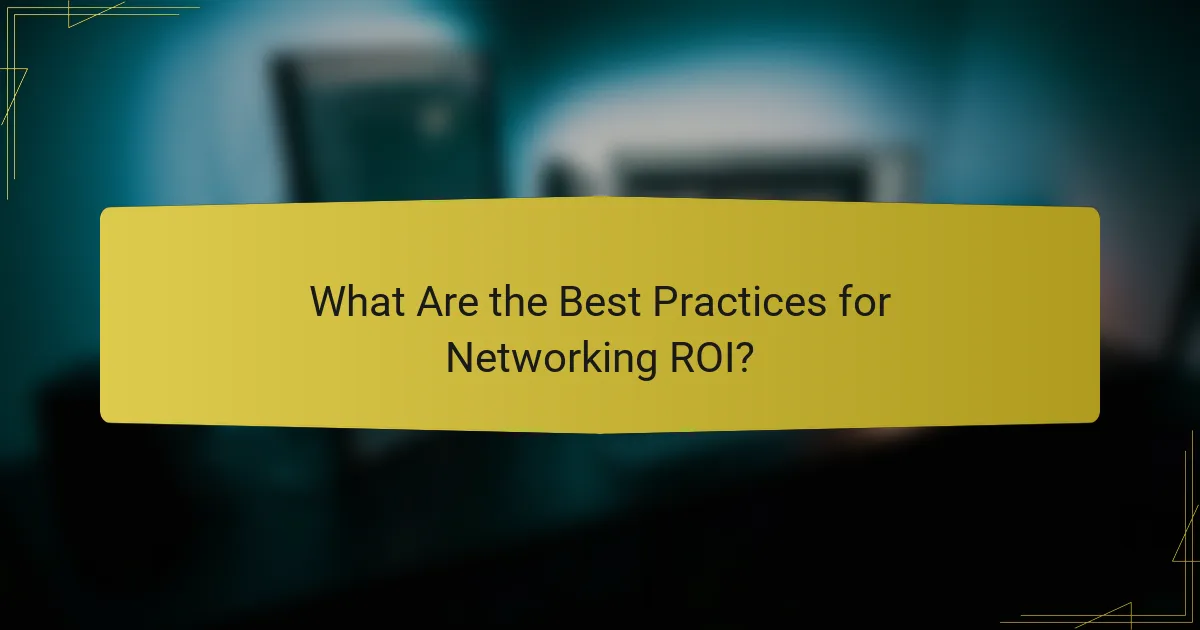Tracking networking ROI for B2B initiatives is essential for evaluating the returns on networking activities relative to their costs. By utilizing various tools tailored to specific business needs, companies can gain valuable insights into their networking effectiveness. Implementing systematic methods, such as regular feedback and customer journey mapping, further enhances the analysis and informs future investment decisions.

How to Measure Networking ROI for B2B Initiatives?
Measuring networking ROI for B2B initiatives involves evaluating the returns generated from networking activities against the costs incurred. This process helps businesses understand the effectiveness of their networking efforts and make informed decisions for future investments.
Define key performance indicators (KPIs)
Establishing clear KPIs is essential for measuring networking ROI. Common KPIs include the number of new leads generated, conversion rates, and customer retention rates. By defining these metrics, businesses can track their progress and assess the impact of networking initiatives.
Consider setting specific, measurable, achievable, relevant, and time-bound (SMART) goals for each KPI. For instance, aim to increase lead generation by 20% within six months following a networking event.
Use financial metrics for evaluation
Financial metrics provide a quantitative basis for assessing networking ROI. Key metrics include revenue growth attributable to networking, cost per lead, and overall profit margins. Calculating these figures helps businesses determine the financial benefits of their networking efforts.
For example, if a networking initiative costs $5,000 and generates $15,000 in new business, the ROI can be calculated as follows: (Revenue – Cost) / Cost = ($15,000 – $5,000) / $5,000, resulting in a 200% ROI.
Implement qualitative assessments
Qualitative assessments complement quantitative metrics by providing insights into the value of networking relationships. Gathering feedback from participants can reveal the perceived benefits of networking, such as enhanced brand awareness or improved partnerships.
Consider conducting surveys or interviews to capture qualitative data. Questions might include how networking has influenced business relationships or the quality of leads generated. This information can help refine future networking strategies.
Utilize benchmarking against industry standards
Benchmarking against industry standards allows businesses to compare their networking ROI with peers. This practice helps identify areas for improvement and sets realistic performance expectations. Research industry averages for networking outcomes to establish a baseline for your own initiatives.
For instance, if the average conversion rate from networking in your industry is around 10%, aim to meet or exceed this benchmark. Regularly reviewing these standards can guide strategic adjustments and enhance overall networking effectiveness.
![]()
What Tools Are Available for Tracking ROI?
Several tools can effectively track ROI for B2B initiatives, each offering unique features tailored to different aspects of business performance. Choosing the right tool depends on your specific needs, such as customer relationship management, sales tracking, social media engagement, or website analytics.
HubSpot for CRM and analytics
HubSpot is a powerful CRM platform that integrates marketing, sales, and customer service tools, making it easier to track ROI across various initiatives. It provides detailed analytics on customer interactions, helping businesses understand how marketing efforts translate into sales.
Utilize HubSpot’s reporting features to create dashboards that visualize key metrics, such as lead conversion rates and customer acquisition costs. This can help identify which marketing strategies yield the highest returns.
Salesforce for tracking sales performance
Salesforce is a leading platform for tracking sales performance, offering robust tools for managing leads, opportunities, and customer relationships. Its reporting capabilities allow businesses to analyze sales data effectively, providing insights into revenue generation and sales cycle efficiency.
To maximize ROI tracking in Salesforce, focus on setting up custom reports that align with your business goals. Regularly review performance metrics to identify trends and areas for improvement, ensuring your sales strategies are data-driven.
LinkedIn Analytics for social engagement
LinkedIn Analytics provides insights into social engagement, helping businesses measure the effectiveness of their B2B marketing efforts on the platform. It tracks metrics such as post engagement, follower demographics, and referral traffic to your website.
Leverage LinkedIn Analytics to refine your content strategy by identifying which types of posts generate the most engagement. This can guide your future campaigns and improve overall ROI from social media initiatives.
Google Analytics for website traffic
Google Analytics is essential for tracking website traffic and user behavior, offering insights into how visitors interact with your site. It helps you measure key performance indicators like conversion rates, bounce rates, and user demographics, which are crucial for assessing ROI.
To effectively track ROI using Google Analytics, set up goals that align with your business objectives, such as form submissions or product purchases. Regularly analyze traffic sources to determine which channels deliver the best returns, allowing for more informed marketing decisions.

What Methods Enhance Networking ROI Analysis?
To effectively enhance networking ROI analysis, businesses should focus on systematic methods that provide actionable insights. Regular feedback, testing strategies, and mapping customer journeys are key approaches that can significantly improve understanding of networking effectiveness.
Conduct regular surveys and feedback sessions
Regular surveys and feedback sessions are essential for gathering insights directly from participants. These tools can help identify what aspects of networking initiatives are working well and which areas need improvement. Aim to conduct surveys shortly after events to capture immediate impressions.
Consider using a mix of quantitative and qualitative questions to gain a comprehensive view. For example, ask participants to rate their satisfaction on a scale of 1 to 10, followed by open-ended questions for detailed feedback. This combination can reveal trends and specific suggestions for future events.
Utilize A/B testing for event strategies
A/B testing allows businesses to compare two different approaches to networking events to determine which yields better results. By varying elements such as event format, timing, or promotional strategies, organizations can gather data on attendee engagement and satisfaction. This method helps in making informed decisions based on actual performance rather than assumptions.
For effective A/B testing, ensure that you have a sufficient sample size for each variant to achieve statistically significant results. For instance, if testing two different networking formats, aim for at least 100 participants per group to draw reliable conclusions.
Implement customer journey mapping
Customer journey mapping visualizes the entire experience a participant has with your networking initiatives. This method helps identify key touchpoints and interactions that influence ROI. By understanding the customer journey, businesses can pinpoint areas where enhancements can lead to better engagement and outcomes.
To create an effective map, gather data from various sources, including surveys, interviews, and analytics. Focus on critical stages such as awareness, consideration, and post-event follow-up. This comprehensive view allows for targeted improvements that can enhance overall networking effectiveness and ROI.

What Are the Best Practices for Networking ROI?
To effectively track networking ROI for B2B initiatives, establishing clear practices is essential. These practices help organizations measure the value generated from networking efforts and ensure alignment with business goals.
Set clear objectives before initiatives
Defining clear objectives prior to networking initiatives is crucial for measuring success. Objectives should be specific, measurable, achievable, relevant, and time-bound (SMART). For example, aim to generate a specific number of leads or establish a certain number of partnerships within a defined timeframe.
Consider aligning networking goals with broader business objectives. This alignment ensures that every networking effort contributes to the overall strategy, making it easier to assess the impact on revenue or market reach.
Regularly review and adjust strategies
Continuous evaluation of networking strategies is vital for optimizing ROI. Schedule regular reviews to assess the effectiveness of networking activities against the set objectives. This could be quarterly or bi-annually, depending on the pace of your industry.
Be prepared to adjust strategies based on feedback and results. If certain networking events or platforms are underperforming, reallocating resources to more effective channels can enhance overall returns.
Engage stakeholders in the evaluation process
Involving key stakeholders in the evaluation of networking initiatives fosters a comprehensive understanding of their impact. Stakeholders can provide valuable insights into what is working and what needs improvement, ensuring that diverse perspectives are considered.
Organize feedback sessions or surveys to gather input from participants. This collaborative approach not only improves the evaluation process but also increases buy-in for future initiatives, as stakeholders feel their contributions are valued.

How to Create a Networking ROI Framework?
Creating a networking ROI framework involves defining clear objectives, identifying your target audience, and establishing methods for data collection and analysis. This structured approach helps organizations measure the effectiveness of their networking initiatives and make informed decisions based on tangible results.
Identify target audience and goals
Start by pinpointing the specific audience you want to engage with through your networking efforts. Consider factors such as industry, company size, and decision-making roles to tailor your approach effectively.
Next, establish clear goals for your networking initiatives. These could include increasing brand awareness, generating leads, or fostering partnerships. Setting measurable objectives will help you assess the success of your efforts later on.
Establish a timeline for assessment
Creating a timeline for assessment is crucial for evaluating the effectiveness of your networking strategies. Determine key milestones for when you will review your progress, such as quarterly or bi-annually, to ensure consistent evaluation.
Align your assessment timeline with your networking goals. For example, if your objective is to generate leads, set a review date shortly after major networking events to analyze the immediate impact on your sales pipeline.
Define data collection methods
Choose appropriate data collection methods to track your networking ROI effectively. Surveys, interviews, and analytics tools can provide valuable insights into the success of your initiatives.
Consider using a combination of qualitative and quantitative data. For instance, qualitative feedback from participants can highlight strengths and weaknesses, while quantitative metrics like lead conversion rates can offer concrete evidence of ROI.

What Challenges Are Associated with Networking ROI?
Measuring the return on investment (ROI) for networking initiatives in B2B contexts presents several challenges. These include difficulties in quantifying intangible benefits, establishing clear metrics, and attributing outcomes directly to networking efforts.
Defining Clear Metrics
Establishing clear metrics is essential for accurately assessing networking ROI. Common metrics include lead generation, conversion rates, and customer retention. However, many benefits, such as brand awareness and relationship building, are harder to quantify.
Attribution Issues
Attributing specific outcomes to networking activities can be complex. Often, multiple factors contribute to a sale or partnership, making it challenging to isolate the impact of networking. Using a combination of qualitative feedback and quantitative data can help clarify these relationships.
Time and Resource Investment
Networking requires significant time and resources, which can complicate ROI calculations. Consider the opportunity cost of time spent networking versus other activities. It’s crucial to balance these investments with expected returns to ensure effective resource allocation.
Intangible Benefits
Many benefits of networking are intangible, such as trust and rapport built over time. While these factors can lead to long-term gains, they are difficult to measure immediately. Incorporating qualitative assessments alongside quantitative data can provide a fuller picture of networking effectiveness.